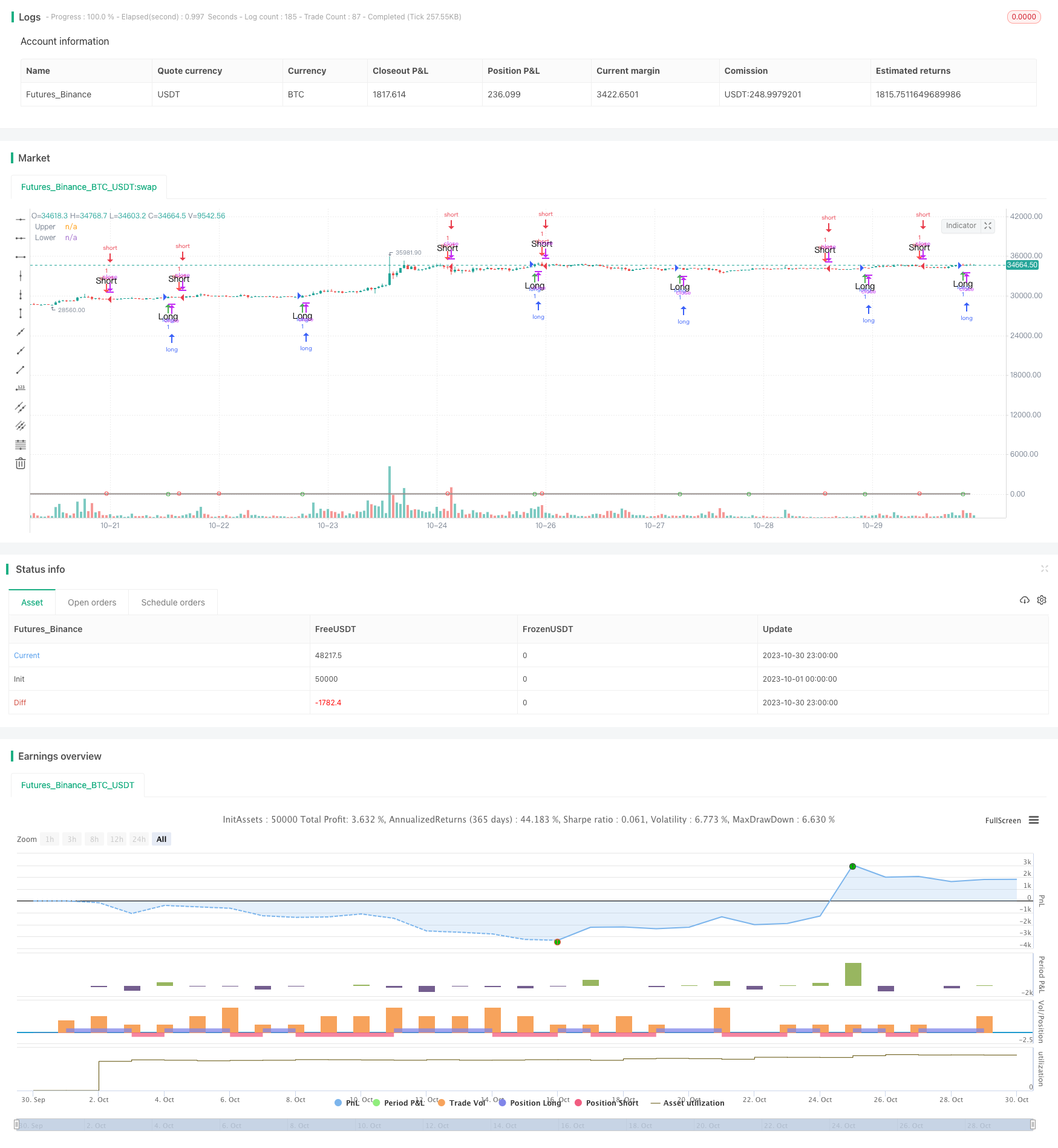
概述
本策略基于Schaff趋势循环指标,结合Stoch RSI的超买超卖原理,通过动量指标实现趋势的判断和跟随。当价格从超卖区突破进入超买区时,做多;当价格从超买区跌破进入超卖区时,做空。该策略通过捕捉价格趋势的变化点,动态调整仓位,追踪价格走势。
策略原理
-
- 计算MACD,其中Fast Length默认值为23,Slow Length默认值为50。MACD反映短期和长期移动平均线的差值,用来判断价格动量。
-
- 对MACD进行Stoch RSI处理,形成K值,其中Cycle Length默认值为10,反映MACD的动量指标的超买超卖。
-
- 对K值加权移动平均,形成D值,其中1st %D Length默认值为3,去除K值中的噪音。
-
- 对D值再次进行Stoch RSI处理,形成初始的STC值,其中2nd %D Length默认值为3,形成精确的超买超卖信号。
-
- 对初始STC值加权移动平均,得到最终的STC值,范围0-100。STC高于75为超买区,低于25为超卖区。
-
- 当STC从下向上突破25时,做多;当STC从上向下突破75时,做空。
策略优势
-
- STC指标结合Stoch RSI的设计,可以清晰识别超买超卖区域,形成较强的趋势信号。
-
- 通过双重Stoch RSI滤波,可以有效过滤假突破。
-
- STC形成0-100标准化的范围,可以便于形成机械化的交易信号。
-
- 该策略回测实现了可视化的突破标记和文本弹窗报警,可以清晰直观地捕捉交易机会。
-
- 策略采用了优化的参数组合,可以有效控制无谓交易,避免过于敏感。
策略风险
-
- STC指标对参数敏感,不同币种和时间周期需要调整参数组合,以适应市场特点。
-
- 突破交易策略容易被套,需要设置止损以控制风险。
-
- 低流动性市场的假突破可能触发错误信号,需要结合成交量等指标进行过滤。
-
- 该策略仅基于STC指标,可结合其它因素判断趋势确认,避免被反转止损。
-
- 需要关注关键支撑阻力位,避免在该区域出现错误信号。
策略优化方向
-
- 优化MACD的参数组合,以适应不同周期和币种。
-
- 优化Stoch RSI的K值和D值参数,平滑STC曲线。
-
- 结合成交量指标,避免低流动性市场的假突破。
-
- 增加其它指标判断,确认趋势信号,例如布林带。
-
- 增加止损机制,例如移动止损或ATR止损。
-
- 调整进入位置,例如突破后回调进入,确保趋势确认。
总结
Schaff趋势循环策略通过动量指标判定超买超卖区域,并以此判断价格中短期趋势的变化。该策略简单明了,可根据不同市场调整参数,但也存在被套风险。可以通过辅助指标判断和止损来优化,在强势趋势中发挥较好效果。
策略源码
/*backtest
start: 2023-10-01 00:00:00
end: 2023-10-31 00:00:00
period: 1h
basePeriod: 15m
exchanges: [{"eid":"Futures_Binance","currency":"BTC_USDT"}]
*/
//@version=3
// Copyright (c) 2018-present, Alex Orekhov (everget)
// Schaff Trend Cycle script may be freely distributed under the MIT license.
strategy("Schaff Trend Cycle", shorttitle="STC Backtest", overlay=true)
fastLength = input(title="MACD Fast Length", defval=23)
slowLength = input(title="MACD Slow Length", defval=50)
cycleLength = input(title="Cycle Length", defval=10)
d1Length = input(title="1st %D Length", defval=3)
d2Length = input(title="2nd %D Length", defval=3)
src = input(title="Source", defval=close)
highlightBreakouts = input(title="Highlight Breakouts ?", type=bool, defval=true)
macd = ema(src, fastLength) - ema(src, slowLength)
k = nz(fixnan(stoch(macd, macd, macd, cycleLength)))
d = ema(k, d1Length)
kd = nz(fixnan(stoch(d, d, d, cycleLength)))
stc = ema(kd, d2Length)
stc := stc > 100 ? 100 : stc < 0 ? 0 : stc
//stcColor = not highlightBreakouts ? (stc > stc[1] ? green : red) : #ff3013
//stcPlot = plot(stc, title="STC", color=stcColor, transp=0)
upper = input(75, defval=75)
lower = input(25, defval=25)
transparent = color(white, 100)
upperLevel = plot(upper, title="Upper", color=gray)
// hline(50, title="Middle", linestyle=dotted)
lowerLevel = plot(lower, title="Lower", color=gray)
fill(upperLevel, lowerLevel, color=#f9cb9c, transp=90)
upperFillColor = stc > upper and highlightBreakouts ? green : transparent
lowerFillColor = stc < lower and highlightBreakouts ? red : transparent
//fill(upperLevel, stcPlot, color=upperFillColor, transp=80)
//fill(lowerLevel, stcPlot, color=lowerFillColor, transp=80)
long = crossover(stc, lower) ? lower : na
short = crossunder(stc, upper) ? upper : na
long_filt = long and not short
short_filt = short and not long
prev = 0
prev := long_filt ? 1 : short_filt ? -1 : prev[1]
long_final = long_filt and prev[1] == -1
short_final = short_filt and prev[1] == 1
strategy.entry("long", strategy.long, when = long )
strategy.entry("short", strategy.short, when = short)
plotshape(crossover(stc, lower) ? lower : na, title="Crossover", location=location.absolute, style=shape.circle, size=size.tiny, color=green, transp=0)
plotshape(crossunder(stc, upper) ? upper : na, title="Crossunder", location=location.absolute, style=shape.circle, size=size.tiny, color=red, transp=0)
alertcondition(long_final, "Long", message="Long")
alertcondition(short_final,"Short", message="Short")
plotshape(long_final, style=shape.arrowup, text="Long", color=green, location=location.belowbar)
plotshape(short_final, style=shape.arrowdown, text="Short", color=red, location=location.abovebar)